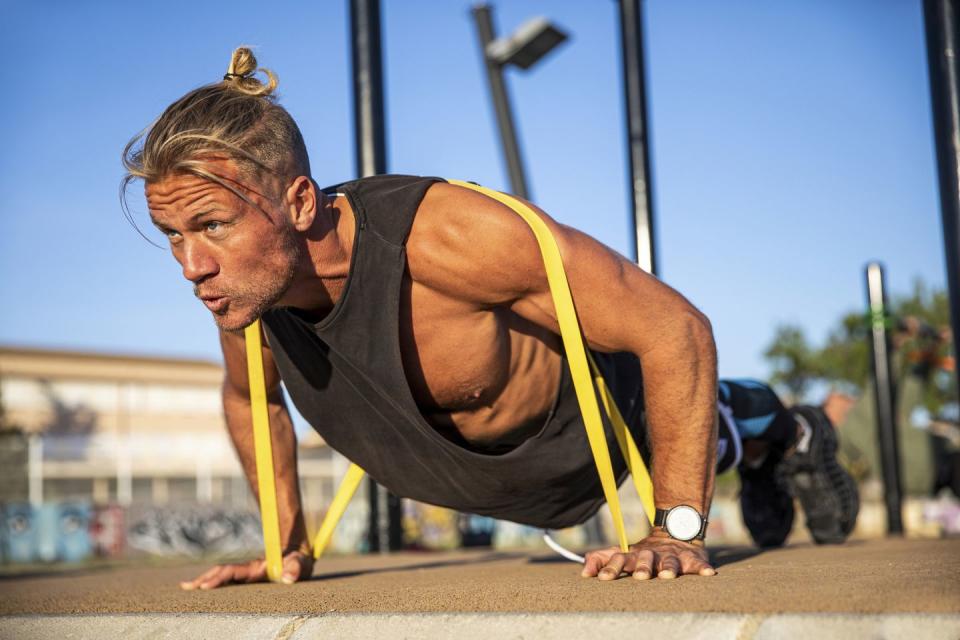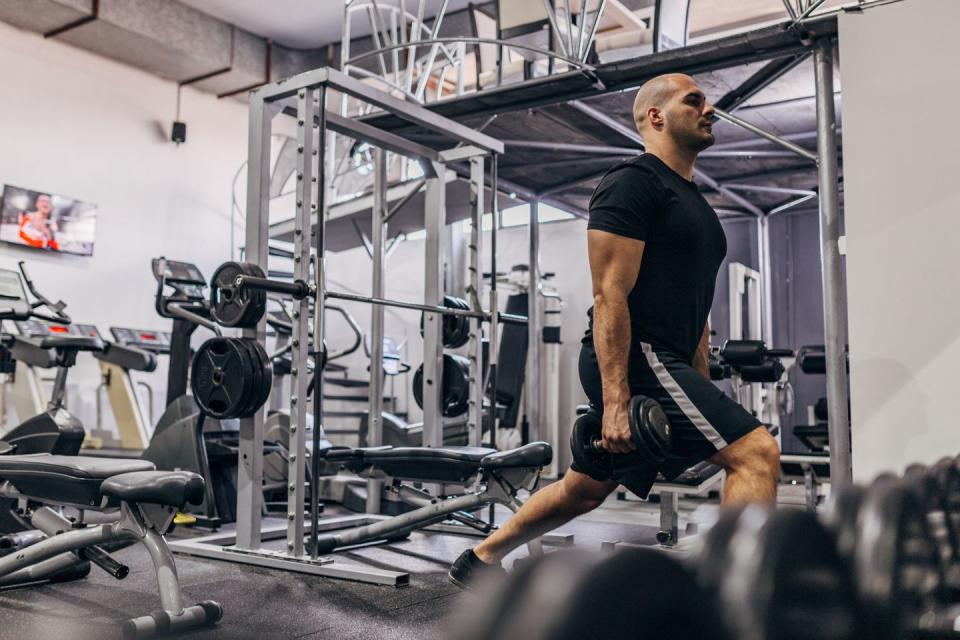5 Barbell Exercises Men Over 40 Should Leave Out of Their Workouts
FOR MANY GUYS over 40 years old, the barbell—once their most prized tool in the gym—eventually becomes an obstacle, making their strength training sessions a challenge.
The heavy loaded exercises the barbell is used for can be painful to perform after years of wear and tear on the joints, making some elder training statesmen trudge around like the walking wounded for days after their workouts at best and increasing their risk of injury at worst. But still, obstinate old school strength junkies will continue to keep grinding away at these movements and base their entire training plan around them. After years of iron experience, that's the only way they know how to go about their workouts if they want to get and stay strong.
Thankfully, you don't have to keep plugging away at the big multi-joint barbell lifts to build and maintain strength. There are other options you can swap in for similar (and sometimes even greater, since you'll be training without pain) muscle and strength gains. Your workouts should be your medicine, after all, not the cause of your maladies.
That said, you should also be sure to train based on your ability, not your age. If you're over 40 and you have the ability to perform any of these barbell exercises without any pain, then go ahead and keep doing them. Just know that if and when you start to feel the effects of all those reps, you have some options to keep your gains going strong.
5 Barbell Exercises Men Over 40 Should Skip
Here are more joint-friendly strength training alternatives to barbell lifts. You'll be able to give your joints a break without compromising the results.
Bench Press
The Problem: If you spend any amount of time in the gym, either you or a guy you know gets shoulder pain from benching with a barbell (just ask Men's Health fitness director Ebenezer Samuel, C.S.C.S.). In fact, it’s not uncommon for guys to who get shoulder pain from benching to say they can do other horizontal pressing exercises, such a dumbbell press and pushups, without issue, since their hands aren't in the same fixed spot on the bar.
The Solution: Band-Resisted Pushup

You can do this exercise using a superband, but I prefer using the gear I developed, the NT Loop, because it’s more comfortable and stable when it is around the body.
To do the band-resisted pushup, lace a band around your upper back and place your fingers (but not your thumbs) inside the band from the bottom up. Position your hands on the floor shoulder-width apart, with your elbows straight. Turn your hands slightly outward so that your fingers point at roughly 45 degrees.
Perform a pushup by lowering your body to the floor while keeping your elbows directly above your wrists. At the bottom of each pushup, position your arms at a 45-degree angle so your torso forms the shape of an arrow. Once your elbows are at an almost 90-degree angle, reverse the motion by pushing your body up so that your elbows are straight again. At the top of each pushup, instead of finishing with your shoulder blades pinched together, protract (push apart) your shoulder blades while keeping your body in a straight line from your head through your hips to your ankles. Do not allow your head or hips to sag toward the floor at any point.
Why It’s Better
Pushups allow more freedom to position your arms in a more comfortable position for your body. You'll be less likely to force your shoulders into internal rotation, which will be a likely culprit of pain and injury.
Plus, a research study comparing band resisted pushups to the bench press found band resisted pushups to be just as effective as bench press at improve pec muscle development and bench press strength, while involving greater core muscle activity.
Barbell Shoulder Press
The Problem: Shoulder pain might limit or prevents overhead lifts. Or, a lack of overhead shoulder mobility forces you to over-extend at your lower back to press the weight overhead, which can create unwanted stress on your spine.
The Solution: Landmine Angled-Barbell Half-Kneeling Press
Place one end of a barbell in a corner or inside a landmine anchor and get into a half-kneeling position, with your legs hip-width apart. Hold on to the other end of the barbell by gripping the handle so your same-side shoulder is directly in line with the opposite end of the barbell. If the barbell is in your right hand, your right knee is down.
Press the barbell up and away from you while keeping your torso upright and stable. Do not press the barbell toward the midline of your body; keep it in line with your same-side shoulder as you press it up and out. Slowly reverse the motion and lower the barbell back in front of your shoulder. At the bottom of each repetition, your forearm should form a 90-degree angle with the barbell. Do not allow your wrists to bend backward at any time; keep your wrists straight throughout this exercise.
Why It’s Better
The position of the landmine allows you to train the same muscles as the overhead press without having the additional, unwanted stress of bringing your arm fully overhead. Plus, the half-kneeling position helps you keep your lower back from overextending.
Barbell Squats
The Problem: Many guys don’t have the shoulder mobility to comfortably hold a heavy loaded bar behind them. A safety squat bar can help to address this problem, since it will allow you to keep your arms in front, but not everyone has access to one unless they also have access to a specialized gym.
Front squats may solve the shoulder mobility issue, but they place more stress on the back because the bar is in front of you. If you have back issues, this might flare up your back even quicker than back squats. Moreover, many guys lack the prerequisite hip and ankle mobility needed to avoid bending too far forward or rounding your back while dropping into a squat, which can place excessive force in your back.
The Solution: Dumbbell Elevated Split Squat

You'll stand on top of an aerobic step (or some other slightly elevated surface) for this exercise, which will provide a greater range of motion than what you'd have if you did the same movement standing on the floor.
Stand tall while holding a dumbbell in each hand at your sides. Stand in a split stance with each foot on top of a small platform or weight plate. Your front foot should be far enough in front of your back foot that your front shin can stay nearly vertical as you drop into each rep.
Keeping your torso upright, lower your body toward the floor without allowing your back knee to rest on the floor. As you lower your body, keep your back straight and torso upright. Drive your front heel into the ground to raise your body to the starting position, thus completing the rep. Perform all reps on one side before switching to the other leg. Keep your weight mostly on your front foot throughout the exercise.
Why It’s Better
The single leg dominant nature of this exercises allows you to create a significant challenge on your lower-body while minimizing load on the spine. Plus, the split-stance position allows you to keep your torso more upright, which is also easier on your back, even if you have less mobile hips and ankles.
Barbell Deadlifts
The problem: Deadlifts can flare up existing back pain for some people. Especially if form isn't perfect, the exercise can cause some guys who don’t otherwise have back pain, to feel very tight and achy in their lower back.
The solution: Trap Bar Deadlifts
You'll need a trap bar for this exercise. Stand inside the bar, with your feet roughly shoulder-width apart. Push your butt back to slowly, then bend your knees lower yourself down to grasp the handles. As you lower your body, keep your feet flat and your knees in line with your toes. Make sure that your hips are lower than your shoulders. Once you have a strong grip on the handles, stand up and squeeze your glutes. Slowly lower back down until the weight plates on the bar touch the floor.
Why It’s Better
The trap bar keeps the weight closer in to your body, which places less load on your lower back. The weight is also at your sides, a more natural position for you to lift off the floor than when you're pulling the bar in front of you.
Barbell Bent-Over Rows
The Problem: You might find that the bent-over position causes back pain, especially as you spend more time under load on the back end of each set. And since your hands are fixed in a position on the bar, you might not be moving in the ideal range of motion for your anatomy.
The Solution: Bench-Supported Dumbbell Single-Arm Row
Rather than putting your knee up on the bench, as is most common, you'll instead hinge at the hips and plant your non-working hand on the bench for support. Your feet, hips, and shoulders should be square, and your shoulders should be higher than your hips, and your spine should be in a neutral position. Squeeze your glutes and abs to create tension, which will help to maintain balance once you begin to row. Tighten your shoulder blades to engage your mid-back, then perform the row by pulling the dumbbell up to your torso so that your working elbow is at a roughly 90-degree angle. Do not allow your working side shoulder to move forward at the top of each rep, and avoid any lumbar movement. Slowly lower the dumbbell toward the floor until your arm straightens without allowing the dumbbell to touch the floor.
Why It’s Better
Bent-over rows wind up with you essentially holding an isometric Romanian deadlift, which places your lower back under significant load for an extended period of time. Using the bench for support drastically reduces the demand on your lower back while still allowing you to work against heavy loads.
You Might Also Like

